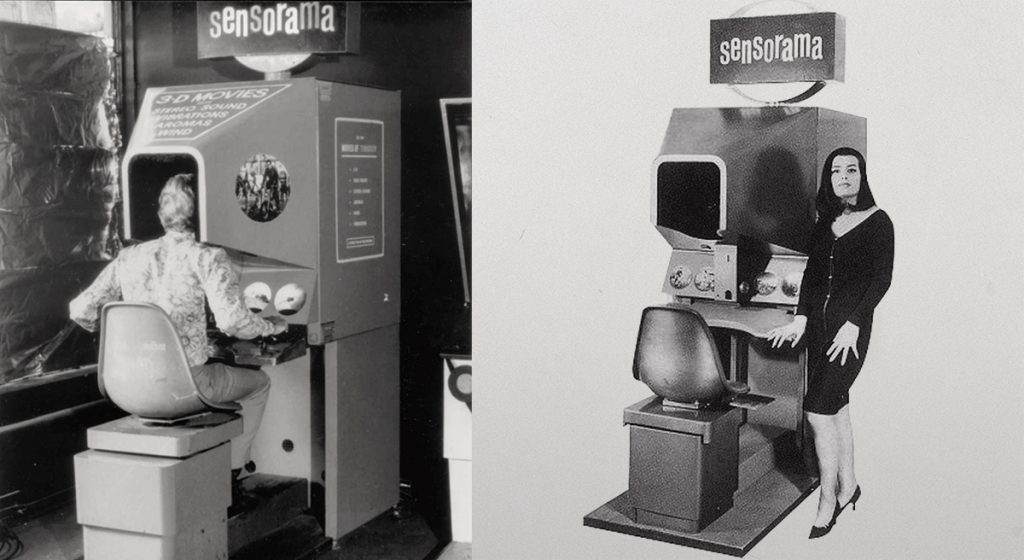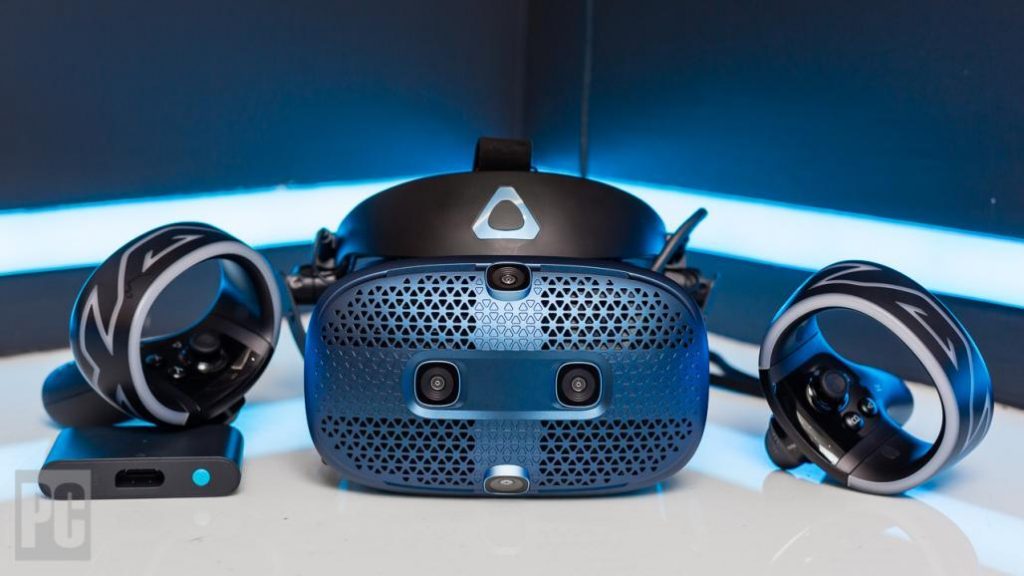
Over the recent years, the buzz surrounding Virtual Reality (VR) has reached an all-time high. Almost everyone who has heard about VR technology is interested in learning more, and perhaps exploring it, at least on some level, and because of this appeal and its many use cases, many have already started using VR technology as part of their personal entertainment or business lives.
Currently, VR technology is being ever more welcomed by a gamers, educators, and people in the business world; but most people are expecting further technological development before widespread adoption occurs.
Enthusiasts and supporters believe VR has the potential to improve and revolutionize many fields including education, architecture, medical, business, research, military, therapy, travel, art, design, just to name a few.
Let’s take a brief look at how we got to be where we are now and what might be on the horizon…
Virtual reality has exploded onto the gaming scene, presenting gamers with a almost magical immersive gateway into their beloved fantasy worlds. But the concept of virtual reality has a long timeline that dates back hundreds of years, long before VR terminology was coined or properly conceptualized.
The modern-day phenomenon of VR was once just an imaginative fantasy that entered the public consciousness through early science-fiction literature and film. No longer are fantastical otherworldly experiences a matter of creative speculations – today, they’re being commercialized around the world.
The technology on the market today is a beautifully refined production of decades of ideation, creativity, and imagination. Here we’ll look at the fascinating history of VR as we look forward to whatever the future has in store next.
1. The early beginnings
Although the technology is new, the term virtual has been used since the 1400’s to mean “being something in essence or effect, though not actually or in fact”, this is the earliest usage of the word as fits into a modern context and is a forerunner of the meaning of virtual that people understand today.
Panoramic paintings
For centuries, the predominant mode of landscape representation was the bird’s-eye view. Bird’s-eye view paintings provided a perspective through the eyes of an onlooker from a high-elevation viewpoint. As an alternative, the panorama offered a new perspective that took the art world by surprise.
1800s panoramic art was introduced in a new era of immersive art that attempted to change the status quo, Panoramas served as mass entertainment for the public and were treated similarly to how people visit theatres or art galleries today.
Featuring a circular 360-degree architecture, panoramic paintings aimed to provide a viewing experience that mimicked the feeling of being present in the moment. The panorama effectively captured the human fascination with creating the illusion that we are present in an experience that is completely removed from actual reality. It’s this desire to be transported elsewhere is what opened the earliest doors to forming the idea of a virtual reality.
Stereoscopic photos & viewers, 1840
Sir Charles Wheatstone research on stereopsis found that the brain understands three-dimensional objects by means of each eye viewing and processing different two-dimensional images. It’s the sum of these perceptions that allows the brain to understand a single object and the distance at which it stands.
Through use of his patented stereoscope device, Wheatstone discovered that viewing two side-by-side stereoscopic images through a stereoscope provided the user with some level of immersive depth perception. Wheatstone’s stereoscope used a pair of mirrors positioned at 45-degree angles to the user’s eyes and a pair of matching images on either end of the device. Even though this is obviously old technology, it is still relevant today. In fact, it’s this design that several VR display manufacturers still use to this day.
2. The tech revolutions of the 20th century
Link Trainer: the first flight simulator – 1929
Having developed a passion for aviation, Edwin Link went on to pursue his dream without the need to fly at all. Link’s first flight simulator came to market in 1929. The machine was completely electromechanical, controlled by motors and gears that simulated the in-plane functionality of a full-scale airplane. Link even included a small device that mimicked turbulence to make the experience as realistic as possible.
The Link Trainer proved to be an incredibly valuable training tool for the U.S. military during World War II and is one of the earliest and most successful examples of early virtual reality for training purposes.
Sensorama – 1962
One milestone was the Sensorama in 1956. Morton Heilig’s background was in the Hollywood motion picture industry. He wanted to see how people could feel like they were “in” the movie. The Sensorama experience simulated a real city environment, which you virtually rode through on a motorcycle. Multisensory stimulation let you see the road, hear the engine, feel the vibration, and smell the motor’s exhaust in the designed simulated world.
Regarded as one of the most progressive pioneers of virtual reality technology, Heilig’s Sensorama was a landmark invention that brought lifelike immersion to the film world. Heilig even produced six short films that he brought to life in this machine.
Just a few years later, Heilig patented the Telesphere Mask, the first VR head-mounted display. The Telesphere Mask aimed to provide users with a sensory experience that would later become the blueprint for many later HMD inventions.

Ivan Sutherland debuts “The Ultimate Display” – 1968
American computer scientist Ivan Sutherland, who is often regarded as the father of computer graphics, amazed the computer research world with his brilliant conception of the Ultimate Display. Sutherland’s vision and ambition for virtual reality was a head-mounted display device that replicated reality so seamlessly that the user would have no way to distinguish the real world from the simulated. His idea was best characterized by three driving points: object interactivity, real-time VR world maintenance, and augmented 3D sound.
Sutherland claimed “The Ultimate Display would, of course, be a room within which the computer can control the existence of matter. A chair displayed in such a room would be good enough to sit in. Handcuffs displayed in such a room would be confining, and a bullet displayed in such a room would be fatal. With appropriate programming, such a display could literally be the Wonderland into which Alice walked.”
Since all aspects of VR technology were so early in development at this time, Sutherland’s 1968 virtual reality HMD, The Sword of Damocles, did not quite live up to his futuristic ambitions, but it served as an important practical and conceptual step forward for future innovations.
The next generation of VR Development
The 1970s and 1980s were an incredible and faced paced time for innovation in the field. Optical hardware advances ran parallel to software advanced, processing power development and projects that worked with haptic devices and other instruments that would allow you to move around in the virtual space.
At NASA Ames Research Centre in the mid-1980s, for example, the Virtual Interface Environment Workstation (VIEW) system combined a head-mounted device with gloves to enable the haptic interaction.
From the 1970s to the 1990s, the VR industry mainly provided devices for medical, flight simulation, car industry design, and military training purposes. NASA also made significant contributions during this time, specifically through the creative work of David Em, who made navigable worlds for NASA’s jet propulsion laboratory.
In 1979, Eric Howlett developed the Large Expanse, Extra Perspective (LEEP) optical system. Users were impressed by the system because of its sensation of depth that was created by the stereoscopic imaging and large field of view and corresponding realism. The LEEP system was redesigned for use by NASA in 1985 and the ideas developed in this project still form the basis for most virtual reality headsets.
Virtual reality gets official terminology – 1982
Despite the pointed aims toward developing virtual reality, a name for the science and sought-after experience still remained nameless well into the 1980s. It’s thanks to Jaron Lanier, founder of VPL Research, that virtual reality earned its name.
The modern use of the term “virtual reality,” as we think of it today, was first used in the mid-1980s when Jaron Lanier, began to develop VR hardware, including HMD goggles and gloves, needed to experience what he called virtual reality.
VPL Research is best known for being the first to sell VR goggles and gloves, and for their massive developments in virtual reality haptics. Products like the DataGlove, EyePhone HMD, and the Audio Sphere were each game-changing devices.
The 1990s saw a boom in both augmented reality and virtual reality, giving users a more sensory feel and for the first time allowing them to see their own body in relation to others in the room.
In 1991, the first cubic immersive room dubbed ‘the cave’ was developed by a PhD student in her thesis. This breakthrough created a multi-projected environment and allowed people to see their bodies in relation to others in the room. During the period of 1989-1992 Nicole Stenger created the first real-time immersive movie named “Angles”. Data glove and high-resolution goggles were used to view the experience. Due in large part to these breakthroughs, the first commercial releases of consumer headsets occurred starting in the 90s.
Attempting to make a mass market: Sega and Nintendo tackle VR – 1993
As the 1990s saw an initial explosion of VR advancement and commercial interest, the rest of the video-gaming world was gaining widespread popularity. It was during this decade that Sega and Nintendo dominated the industry, seeing worldwide success with every new console and compatible game release. With the rapid development and bubbling excitement behind virtual reality, both tech titans decided to capitalize.
The Sega VR headset for the Sega Genesis debuted to the world in 1993. The HMD featured a wrap-around architecture that featured basic head tracking, stereo sound, and integrated LCD screens. Priced at $200, there was plenty of buzz about Sega’s latest gadget. However, due to a number of technical obstacles, the device was never able to hit consumer markets. The project unfortunately ended as a failure,
Following Sega’s lead, Nintendo tried their hand at a 3D gaming console. The Nintendo Virtual Boy was hyped up as the world’s first portable console that was capable of showcasing true 3D graphics. The device hit consumer markets in Japan and North American in 1995, but sales were massively disappointing. The device was very bulky, difficult to use, expensive, and very limited in its capabilities, it featured LCD screens of very low resolution that could display red pixels only. Most people just didn’t think it was fun compared to conventional video gaming. Because of the system’s glaring shortcomings, production came to a full stop the next year.
For two major gaming forces to see such devastating virtual reality failures, the motivation to invest in VR subsided, eventually fading out of the interactive media industry’s focus for years.
3. The Modern era of VR Development 2000 – Present
Since the year 2000, there has been continued growth in VR technology and is the period with the most tremendous innovation since VR’s inception. In 2001, SAS Cube created the first PC based cubic room that then led to the development of Virtools VR pack, a library pack add-on.
After the 2007 release of google Street View, in 2010, google introduced stereoscopic 3D mode for Street View. This allowed users to stand on the street and physically look around the 3D image.
As 2010 arrived with a new decade, an 18-year-old called Palmer Luckey created the first prototype of Oculus Rift, the now famous VR headset.
A Modern VR revival
Oculus Rift – 2010
2010 was a big year for 18-year-old entrepreneur Palmer Luckey’s. The Californian teenager spent his childhood years completely obsessed with the computer-generated worlds of virtual reality. After building and experimenting with over 50 different head-mounted VR models, his passion led to the creation of his first prototype of the Oculus Rift. Boasting an impressive 90-degree field of view, Luckey’s earliest Oculus Rift brought plenty of progress and innovation to the VR world that had never been seen before.
The Oculus Rift addressed a number of frustrations and concerns Luckey found with existing VR systems, from unimpressive field-of-view and low resolution, high latency displays to the weighty bulk and pricey costs. Luckey’s invention was a modern re imagination of the head-mounted VR devices of the past decades.
Within a couple of years, Oculus Rift was able to earn an astounding $2.4 million on Kickstarter, an incredible accomplishment for a teenager who would go on to sell the oculus company to Facebook, who purchased it for $2 billion.
His decision to sell the company to Facebook generated a lot of rage on Reddit, yet there was so much progress with the technology that this didn’t seem to matter in the end.
This enormous commercial move served as a defining moment in VR history as it added momentum to the modern digital age. Shortly after, Sony announced its plan toward the development of Project Morpheus: a head-mounted VR display designed to be compatible with the PlayStation 4. Facebook’s highly-publicized move shot VR back into mainstream public interest, energizing tech enthusiasts all around the world.
2014 was also the year that Samsung announced the Samsung VR gear, a VR headset that works but using a Samsung smartphone, that would eventually be released in 2016.
The Google Cardboard was an unexpected move made by the giant search engine company. Engineered to be a super low-cost, do-it-yourself stereoscopic viewer for smartphones, Google Cardboard continued the vision of early inventors’ attempts at easily-built, minimalist virtual reality. The product effectively encouraged consumer interest in VR devices and applications, in an attempt to encourage the world to look forward towards even bigger innovations.
Popularization and gaming – 2016
By 2016, companies all around the globe were making significant strides toward the development and production of VR products. It was made abundantly clear that Luckey’s Oculus Rift was the VR genius that set the industry ablaze once again.
With both the Oculus and Project Morpheus in rapid production, the gaming world became subject to VR testing once more. Having learned from Sega and Nintendo’s mistakes and shortcomings decades before, Facebook and Sony made carefully strategized moves as progress was made.
Oculus promised to make good on Luckey’s original intention to revive VR gameplay experiences with full 3D immersion that proved to be more lifelike than any previous head-mounted VR displays. Likewise, Sony’s Morpheus promised the same immersive gameplay.
Valve, the much loved computer game company responsible for incredibly successful gaming franchises like Half Life, Counterstrike, Portal and Dota, decided they needed to have an important part in the VR revival of the modern era. The decided to make their own Headset called the Vive, which would aim to make a device for the higher end of the market and work seamlessly with the Steam VR online store software. In 2016, HTC Vive, Oculus Rift and Playstation VR were all released. It is also the first year, many say, that VR became truly accessible to consumers in their own homes for gaming and media entertainment.
All headsets had accompanying hand-held devices that allowed for movement and use of hands when interfacing with VR.
2017 was the year that bridged the gap between expectations and reality. In 2016, many were excited about VR potential, but thought that the content was sparse and the price of VR headsets too expensive. In 2017, Sony bundled PS4 consoles with PSVR headsets in order to attract more users. This fact paired with Oculus’ summer sale of hardware spurred the purchasing of VR headsets and gear.
At an annual conference detailing hardware, software and content innovation in VR, Oculus announced: The Oculus Quest, which became available in Spring 2019, which is their first all-in-one headset with positionally tracked controllers; an exclusive Star Wars game that allows the player to take up a lightsaber like a Jedi; and a professional grade, set ready 3D/360 camera created in partnership with Facebook and RED. At the E3 video game conference, HTC announced an adapter for the Vive.

VR’s Significance as a non-gaming platform – Now
With such massive names in tech running the engines behind the advancement of VR, industry heads outside of the gaming sphere quickly capitalized on the potential for its many uses. Companies like Walmart, ExxonMobil, and Verizon have all transformed the face of their employee training programs by switching to virtual reality learning. Employers are better able to teach new employees the rules, expectations, and codes of action via VR by inserting trainees into lifelike situations.
The United States military has adopted virtual reality training technology to prepare soldiers for the battlefield. From flight simulators for pilots and medical training for doctors, to vehicle simulation for tank crews and combat training for infantry soldiers, there are a myriad of uses for VR that are reshaping the armed forces.
Some other areas that are benefiting from the ability to simulate worlds in VR are education, medicine, and architecture, which are every increasingly adopting VR into their daily lives for simulation, visualization, and training.
4. The Future of VR
Today, virtual reality has been transformed into something early researchers and inventors had once dreamed for it to be, and potentially so much more. VR is being used in a vast variety of industries all around the world, from providing eSports professionals with lifelike gaming experiences to helping doctors simulate real-life medical procedures. As VR becomes more widely accessible, its applications will continue to expand and impress; Perhaps once day it will be thought of as just a normal part of our daily lives, as in television and the internet became.
The fundamental premise behind virtual reality has persevered over many long decades; answering the call of a dreamer’s desire to go beyond the confines of reality. While monumental leaps have been made toward the development of virtual reality, there will soon come a time where such head-mounted displays are looked upon as obsolete, clunky, and primitive, and just another link to the chain towards the development of even more advanced technology. With so many influential tech giants working hard and investing towards creating the ultimate VR hardware and software experiences, the future of virtual reality shines bright with limitless potential.

